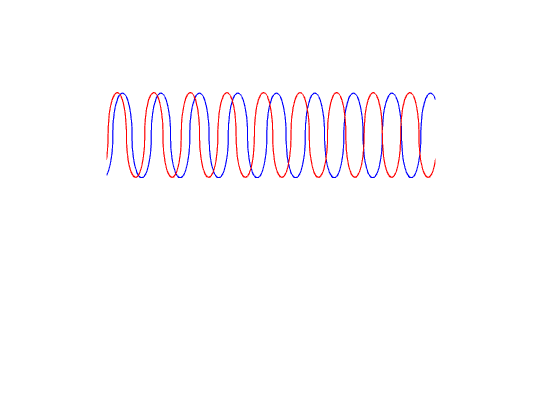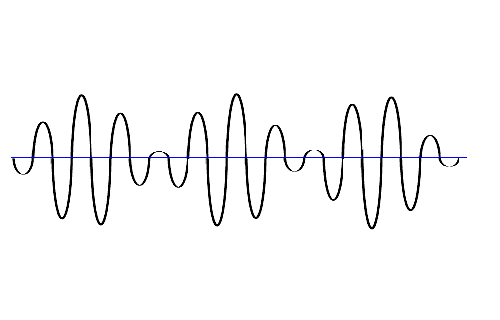Vibrato
North Suburban HAMMOND ORGAN Service

Figure 3.
Heterodyne Vibrato
Figure three above is a look at two sound waves that are close in frequency. For clarity, one is red and the other, blue. Here, you can see how, as they progress, they get in and out of phase as indicated by the places where they coincide and where they are opposite. The difference in frequency is indicated by the difference in speed that they traverse the picture from left to right. But you must understand that in reality both sound waves travel at the same speed. But for the purposes of the illustration, and to demonstrate graphically how they get in and out of phase, the easiest way to show that is by making the two illustrations travel at slightly different rates. I guess we could say that here I am taking a kind of artistic license to create an illustration.
When the waves are in phase, they add together, producing a louder sound, and when out of phase, they cancel causing a reduction in the sound level. Therefore, you would think that the end result would be a simple tremolo. However, this is not so. The animation below shows in motion the audible result of combining two sound waves with slightly different frequencies. As you can see, it looks quite different from the previous picture of simple tremolo. In fact as you look at it, it has, to use an example from biology, an almost peristaltic action. At the end of this article, we'll include a few small sound clips which will let you hear the differences between the various effects that we're talking about.
This type of vibrato is referred to as [among other terms] a heterodyne vibrato. It is formed, as the diagram above shows, when two soundwaves having very nearly the same frequency are sounded together.
A heterodyne vibrato can be used two ways. When the pitch difference between the two sounds is very close, the result is called a celeste, which is a slow wavering in the tone. It almost has a sense of motion to it and the effect is used a lot in pipe organs. Indeed, a slow celeste effect is present in nearly all musical situations where more than one sound source is active at the same time. Even if several different instruments are playing the same note, because they are not synchronized you get slight discrepancies. When this happens, we are not really consciously aware of it, but if it is missing, the result sounds somewhat "lifeless, dull, uninspiring and boring," to use a few of the more commonly applied adjectives.
When the pitch difference between the two sound waves is between six to seven Herz, then the result becomes a type of vibrato which is quite different from a normal vibrato. The heterodyne or "beat" as it's often called occurs at the same rate as the DIFFERENCE between the two tones. In a situation where many different instruments (or organ pipes) sound together, the effect becomes infinitely complex.
One of the best uses of a heterodyne vibrato that I have heard is the vibraharp tremolo effect that is used in the X77 Hammond organs. The vibraharp signal is split in two, one signal is unaffected, and the other signal is increased in frequency by around 6 Hz. Then the two mix as sound waves in the air because they come from separate speakers. The result is a very realistic vibraharp. On those electronic organs where a simple vibrato is applied to a percussion sustained flute sound to create the illusion of a vibraharp, the result is not at all realistic, because the type of vibrato which occurs in a real vibraharp is entirely different from a simple vibrato.

Figure 4. Heterodyne Vibrato
By means of modern digital signal processing, we can increase the frequency of any signal by a specific amount so that when we combine that with the direct signal, we will end up with a nice heterodyne vibrato effect. The sound of a heterodyne vibrato does include, as you would expect, a strong amplitude varying tremolo effect, but it is different; the pitch or frequency difference between the two soundwaves does exert a subtle pitch effect in addition to the tremolo component, and thus the heterodyne vibrato is much more interesting to listen to than a simple tremolo. It also increases in complexity (interest) as soon as the tones leave the musical instrument speaker(s).
In figure four as you can see, there is an amplitude variation effect in a heterodyne vibrato, but it "moves along" the wave and the entire soundwave is not uniformly affected as it is when undergoing a simple tremolo. BTW, stare at either of these long enough on a computer and you may become hypnotized! In the event that you do become hypnotized, your post hypnotic command is: "make a generous financial donation to our Hammond organ repair service, and do it right away!"
Previous Page Page 2. Next page